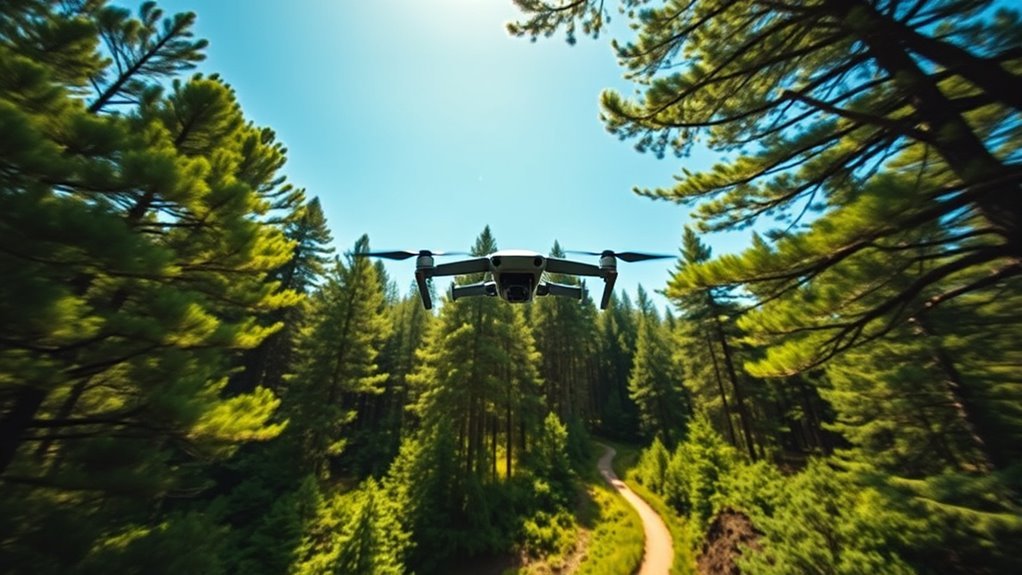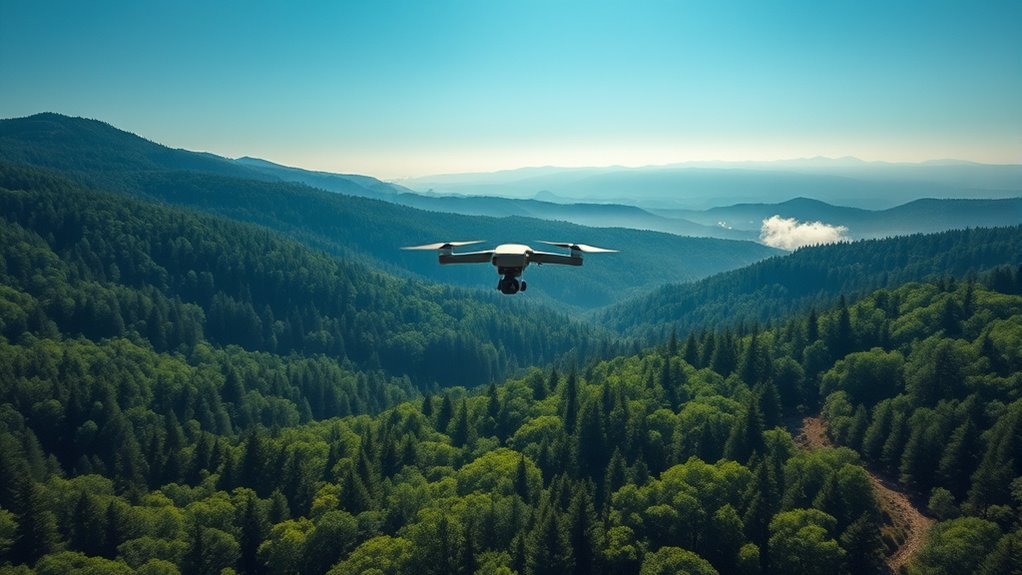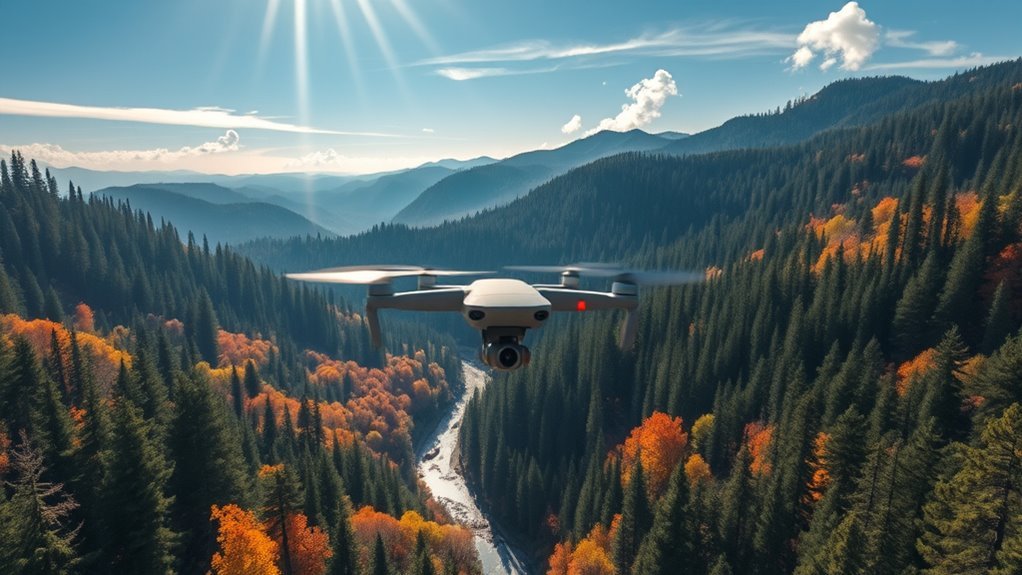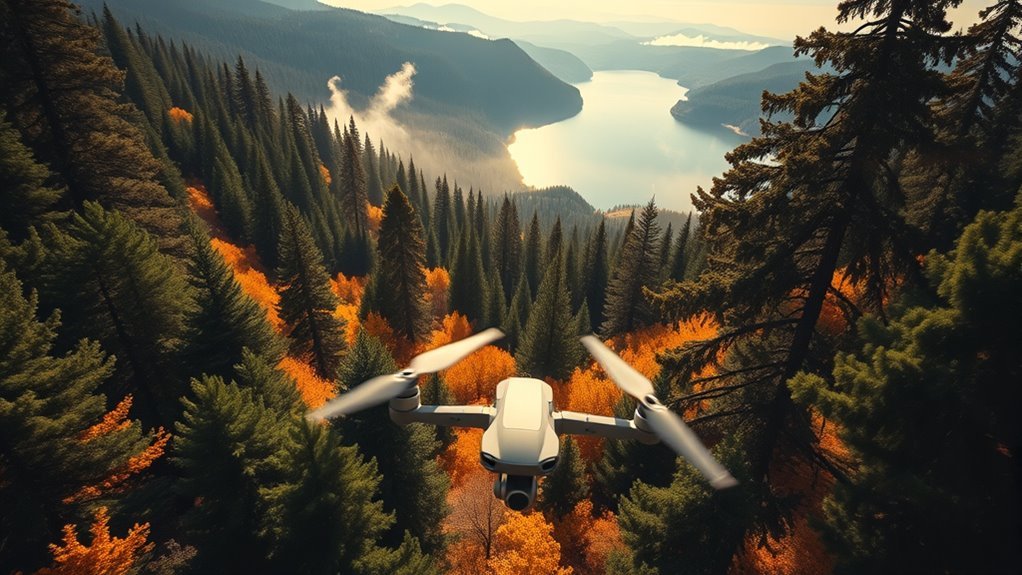To master flying drones in national forests, you need to understand regulations like obtaining permits and adhering to noise guidelines. Choose a drone with a high-resolution camera and strong battery life for stunning shots. Conduct a thorough pre-flight checklist, making certain equipment is in top shape and checking weather conditions. Respect wildlife by maintaining distance and minimizing disturbances. By following these essential tips, you’ll enhance your aerial adventures and guarantee you’re compliant with local laws while capturing breathtaking footage.
Understanding National Forest Regulations

When you’re considering flying drones in national forests, it’s important to understand the specific regulations that govern their use. First, you’ll need to obtain the appropriate drone permits, as many national forests require authorization to operate in designated areas. Familiarizing yourself with these requirements is essential to avoid fines or penalties. Additionally, noise regulations play a significant role; drones can disturb wildlife and other visitors, so adhering to sound limits is a must. Be aware that each national forest may have unique rules, so checking local regulations is critical before your adventure. By respecting these guidelines, you not only guarantee compliance but also contribute to preserving the natural beauty and tranquility of these cherished areas.
Choosing the Right Drone for Your Adventure

How do you choose the right drone for your adventure in national forests? Start by considering essential drone features, such as camera quality, battery life, and ease of use. If you’re capturing stunning landscapes, a high-resolution camera is vital. Battery life is equally important; a longer flight range allows you to explore further without constantly worrying about recharging. Look for drones with robust GPS capabilities to guarantee stability and precise navigation in varying terrains. Additionally, think about portability; lightweight models are easier to carry during hikes. Always check weight limits and local regulations to guarantee compliance. By selecting a drone that meets these criteria, you can maximize your freedom to explore the breathtaking beauty of national forests safely and responsibly. For example, drones like the Draganfly Vital Intelligence offer up to 25 minutes of flight time per charge, enhancing your exploration capabilities. Understanding the battery capacity of your drone can significantly impact your flight duration and range.
Pre-Flight Checklist for Safe Operations

Before launching your drone in a national forest, it’s crucial to conduct a thorough pre-flight checklist to guarantee safe operations. Start with a detailed equipment inspection; verify your drone’s battery is fully charged, propellers are secure, and there are no signs of damage. Check that your firmware is up to date for peak performance. Review the weather conditions, avoiding high winds or precipitation that could affect flight stability. Confirm you’re aware of any no-fly zones and local regulations that may apply, as federal laws govern drone operations in various areas. Finally, perform a quick systems check, verifying all controls are responsive. Following this pre-flight safety protocol not only enhances your experience but also promotes responsible flying, allowing you to enjoy the freedom of the skies safely. Additionally, ensure that you have obtained the necessary permits from the U.S. Forest Service to operate your drone legally in national forests.
Best Practices for Respecting Wildlife
While enjoying the thrill of flying your drone in national forests, it is vital to prioritize wildlife conservation. Respecting the natural habitat is essential for ethical flying. Keep your distance from nesting sites, and avoid areas where wildlife is known to congregate, especially during mating seasons. If you’re interested in wildlife photography, use zoom lenses to capture images from afar, minimizing disturbance. Always follow local regulations regarding drone flights, as they often include specific guidelines to protect wildlife. Be mindful of your drone’s noise levels; excessive noise can stress animals. By practicing these best practices, you’re not only ensuring a more enjoyable experience but also contributing to the preservation of the beautiful ecosystems you’re exploring.
Tips for Capturing Stunning Aerial Footage
Capturing stunning aerial footage with your drone can elevate your outdoor adventures in national forests, turning breathtaking landscapes into unforgettable visuals. To achieve great results, focus on the following tips:
- Plan Your Shots: Scout your location for ideal lighting and angles to enhance your aerial composition. Golden hours, like sunrise or sunset, create magical lighting, and considering the drone’s camera quality and features can help you maximize image clarity.
- Ensure Drone Stability: Utilize features like GPS and gimbal stabilization to keep your footage smooth and professional. Avoid windy conditions that can affect stability, as strong maneuverability and stability are crucial for achieving impressive results.
- Experiment with Angles: Don’t hesitate to try various heights and perspectives. Low angles can provide dramatic views, while high altitudes reveal vast landscapes. Additionally, be aware of local regulations regarding drone use in national forests to ensure a lawful flying experience.
Frequently Asked Questions
Can I Fly My Drone at Night in National Forests?
You can’t fly your drone at night in national forests without proper lighting and adherence to safety regulations. It’s essential to guarantee visibility and compliance to maintain safety while enjoying the freedom of night flying.
Are There Specific Drone Height Restrictions in National Forests?
While you crave freedom in the skies, remember that drone altitude regulations in national forests impose strict limitations. Guarantee you’re aware of forest airspace restrictions to avoid penalties and keep the wilderness safe.
How Do I Report Drone Incidents in National Forests?
To report drone incidents in national forests, contact the local forest service or park ranger. Make certain you provide detailed information, as incident reporting contributes to drone safety and helps maintain the freedom to fly responsibly.
What Should I Do if Wildlife Approaches My Drone?
If wildlife approaches your drone, maintain distance to guarantee drone safety and prevent distress. Avoid sudden movements, and consider landing your drone to minimize wildlife interactions. Always prioritize their well-being while enjoying your flying experience.
Are There Any Drone Flying Clubs in National Forests?
While there aren’t specific drone flying clubs in national forests, you can connect with local groups online. Always prioritize drone safety and adhere to flying etiquette to guarantee a respectful experience for everyone involved.

